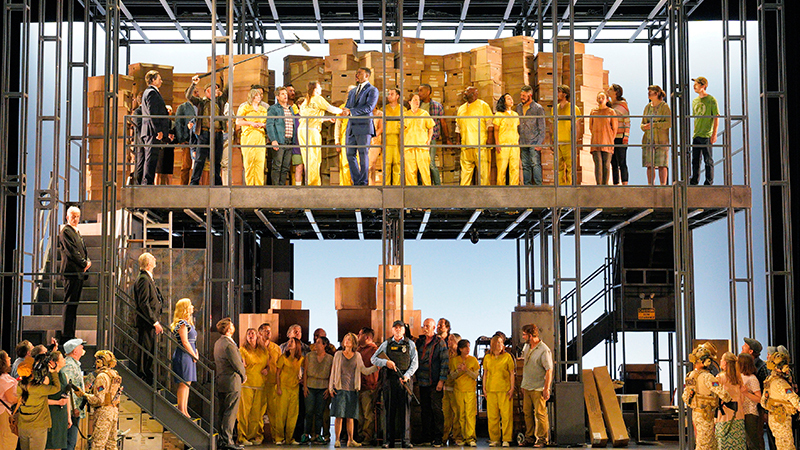-
10 Things to Know about FIDELIO
By COC StaffPosted in 23/24 Season
Beethoven’s only opera returns to the COC for the first time in nearly 15 years, in a brand new production reflecting the bold creative vision of acclaimed director Matthew Ozawa. Ozawa’s staging uses revolving steel cages, industrial lights, and television screens to create an opera as arresting visually as it is musically—a revolutionary retelling of Beethoven’s triumphant hymn to justice and freedom.
Read on to learn 10 things to know about Fidelio before heading to the opera!
Spoiler alert: the following content contains plot points that some audience members may not wish to know in advance!
BUY TICKETS
Beethoven's bête noireBeethoven found the process of writing and producing an opera nothing less than tortuous, and he vowed that he would never compose another. Still, despite his struggles to bring Fidelio to completion, he later wrote that “It is the work that brought me the most sorrow, for that reason it is the one most dear to me.”A story of hope and heroismThe story begins with a woman, Leonore, disguising herself as a male guard named Fidelio to enter the prison where she suspects her husband is being held as a political prisoner. Here she discovers a world of abuse and oppression, as well as a sinister plot to kill her husband before the perpetrators can be held accountable. Undeterred, her actions offer hope and strength to those she encounters, building fresh impetus for political resistance.
A revolutionary opera
As a young man, Beethoven had been appalled by the political violence and gross abuses of power that raged through Paris following the French Revolution. Fidelio was his response to what he witnessed and a celebration of justice, freedom, and the power of the human spirit to triumph over tyranny. One of several rescue-themed works that were popular at the time, the opera celebrates the heroism of its main character, Leonore, as well as the great humanitarian ideals of the age.
Fidelio or Leonore?
Fidelio was originally titled Leonore! The first two incarnations of the opera, which premiered in Vienna in 1805 and was restaged the following year in a shortened version, were billed as Fidelio to prevent confusion with other contemporary operas that also included the name Leonore in their titles, such as Pierre Gaveaux’s Léonore, ou l’amour conjugal. Convention is now to refer to the first two versions as Leonore, and to the final iteration, which appeared in 1814, as Fidelio.

Schubert was thereThe 17-year-old Franz Schubert attended the 1814 premiere, having sold his school books to afford a ticket. Beethoven conducted the performance himself, despite the fact that his hearing loss was already quite advanced by this point. The role of the prison governor, Don Pizarro, was sung by Johann Vogl, who would later become one of Schubert’s most important musical collaborators.
Musical highlight: the Prisoners' ChorusPerhaps the most famous ensemble piece from the opera is the rousing “O welche Lust” ("O what joy"), popularly known as the Prisoners’ Chorus. This ode to freedom, constructed in overlapping four-part harmony, is sung by a group of political prisoners who have been allowed outside for a rare breath of fresh air. “Oh what joy, in the open air freely to breathe again!” they sing. “Up here alone is life! The dungeon is a grave.”
Multiple overturesBeethoven struggled with the composition of the overture, working through four different versions before settling on what is now known as the Fidelio overture, in E major, for the 1814 revival. Although this is the version that is generally played in modern productions, his second attempt (in C major) is considered by many to be the greater piece musically (and is sometimes performed as a concert piece); as a full-scale symphonic movement, however, it was thought to overwhelm the opening scenes of the opera.

A hymn to freedomFidelio was the first opera to be performed in Berlin after the end of World War II, by the Deutsche Oper at the Theater des Westens, in September 1945. Somewhat surprisingly, the anti-tyrant opera hadn’t been banned by the Nazis, causing the novelist Thomas Mann to observe “What amount of apathy was needed [for audiences] to listen to Fidelio in Himmler’s Germany without covering their faces and rushing out of the hall!”
Historic resonances
Fidelio opened at the Semperoper in Dresden in October 1989 to mark the 40th anniversary of the East German DDR, producing such applause following the Prisoners’ Chorus that the performance was temporarily delayed. One month later, the fall of the Berlin Wall signalled the beginning of the end of the Cold War and the reunification of East and West Germany.
A personal connection
The story of Fidelio is deeply personal to Japanese-American director Matthew Ozawa, whose father was born during World War II in a Montana internment camp for Japanese-Americans. In this production, Ozawa sets the action in a modern-day prison facility, reminding audiences that Beethoven’s warnings about power and corruption remain as relevant today as when Fidelio was composed over 200 years ago.
Fidelio opens September 29 at the Four Seasons Centre for the Performing Arts!
BUY TICKETS
Photos: Cory Weaver
